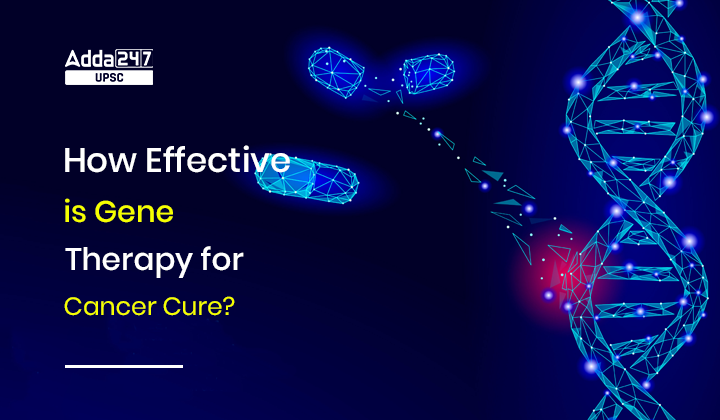Table of Contents
How Effective is Gene Therapy for Cancer Cure?
How Effective is Gene Therapy for Cancer Cure?:
- Gene therapy is a medical approach that treats or prevents disease by correcting the underlying genetic problem. Gene therapy techniques allow doctors to treat a disorder by altering a person’s genetic makeup instead of using drugs or surgery.
- Gene therapy, which involves replacement of a defective gene with a functional, healthy copy of that gene, is a potentially beneficial to cure cancer.
Genome Editing and CRISPR-CAS9: Definition | Working | Advantages | Challenges
What is the Case?
- Scientists in the United Kingdom testing a new form of cancer therapy, reported success in a teenaged girl, Alyssia, with a form of cancer called Tcell acute lymphoblastic leukaemia.
- The team at Great Ormond Street used a technology called base editing, which was invented only six years ago.
What happens in Tcell acute lymphoblastic leukaemia?
- In this form of blood cancer, the Tcells, which are a class of white blood cells, equipped to hunt and neutralise threats to the body, turn against the body and end up destroying healthy cells that normally help with immunity.
- The disease is rapid and progressive and is usually treated by chemotherapy and radiation therapy.
What is ‘base editing’ Technique?
- Bases are the language of life. The four types of base – adenine (A), cytosine (C), guanine (G) and thymine (T) – are the building blocks of our genetic code.
- Just as letters in the alphabet spell out words that carry meaning, the billions of bases in our DNA spell out the instruction manual for our body.
- Or we can say, a person’s genetic code is several permutations of four bases: Adenine (A), Guanin (G), cytosine (C) and thymine (T).
- In Alyssia’s case, her Tcells — perhaps because of a misarrangement in the sequence of bases — had become cancerous. A way to correct this misarrangement could mean a healthier immune system.
What is CRISPR Technique?
- In the last two decades, the world of biomedical engineering has been enthused by a technique that allow genes to be altered and errors ‘fixed.’ The most popular among these approaches has been the CRISPRcas9 system.
- Inspired by how certain bacteria defend themselves against viruses, by snipping out and storing pieces of their genes, the CRISPRcas 9 system, consists of an enzyme that acts like molecular scissors.
- It can be made to cut a piece of DNA at a precise location and a guide RNA can be used to insert a changed genetic code at the sites of incision.
- While there are a few ways to effect such changes, the CRISPR cas9 system is believed to be the fast, most versatile system to effect such gene editing.
- While still a nascent technology, base editing is reportedly more effective at treating blood disorders which are caused by socalled single point mutations, or when a change in a single base pair can cause terminal disease.
How did baseediting work for Alyssia’s therapy?
- The objective of the gene therapy in the case of Tcell leukamia was to fix her immune system in a way that it stops making cancerous Tcells.
- First, healthy Tcells were extracted from a donor and put through a series of edits. The first base edit blocked the Tcells targeting mechanism so it would cease attacking Alyssa’s body, the second removed a chemical marking, called CD7, which is on all Tcells and the third prevented the cells being killed by a chemotherapy drug.

- Finally, the Tcells were programmed to destroy all cells — cancerous or protective — with CD7 marked on it. After spending a month in remission, she was given a second donor transplant to regrow her immune system that would contain healthy Tcells.
- Three months after the treatment, her cancer seemed to resurface but the most recent investigations suggest no signs of it.
Biotechnology: Definition, Application and Challenges
Recent Science and Technology Current Affairs Articles:




 TSPSC Group 1 Question Paper 2024, Downl...
TSPSC Group 1 Question Paper 2024, Downl...
 TSPSC Group 1 Answer key 2024 Out, Downl...
TSPSC Group 1 Answer key 2024 Out, Downl...
 UPSC Prelims 2024 Question Paper, Downlo...
UPSC Prelims 2024 Question Paper, Downlo...





